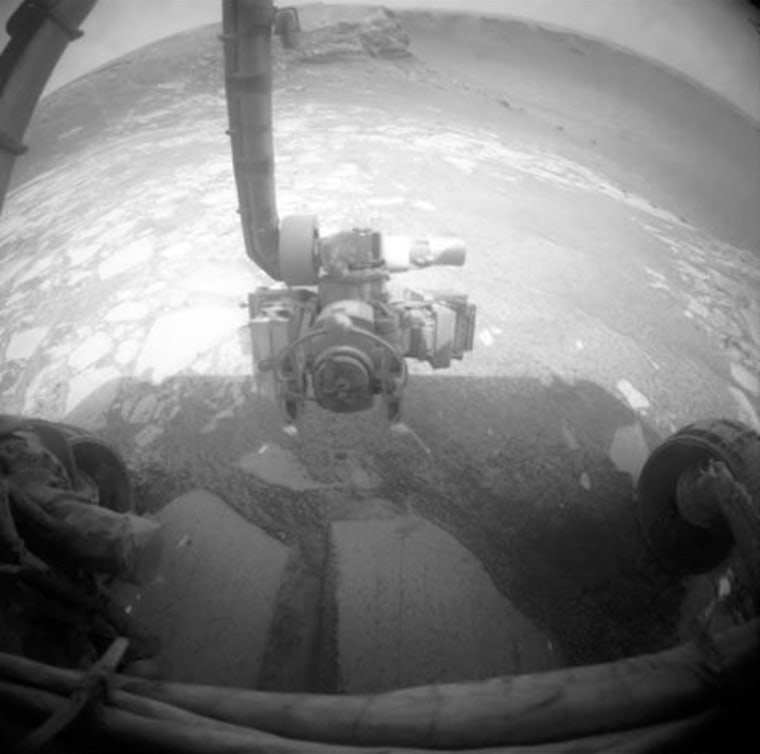NASA's Mars rover Opportunity has arrived at its first stop inside an expansive crater, where it is poised to reach out and touch what may be the ancient remains of the red planet's surface, mission managers said Wednesday.
Opportunity is perched on the wall of Victoria Crater, a half-mile (about 800-meter) wide scar in the surface of Mars that has long been a goal for the six-wheeled NASA robot. The rover began its descent into the crater in earnest earlier this month, and now sits before a bright band of material that runs along Victoria's walls much like the ring around a bathtub, mission managers said.
"We suspect that this bright band of material is the ancient surface of Mars prior to the impact that created Victoria," Mars rover project manager John Callas, of NASA's Jet Propulsion Laboratory in Pasadena, Calif., told SPACE.com Wednesday. "It's composed of three distinct layers that we can see in the imagery."
Victoria is the largest crater visited by Opportunity during the rover's nearly four Earth years of red planet exploration. Researchers hope to learn new details about how Mars' atmosphere interacted with its surface millions of years ago by using the Opportunity's sensors, cameras and robotic-arm mounted tools to sample Victoria Crater's different rock layers.
"This will be the first of several stops within this band of rock," said rover science principal investigator Steven Squyres, of Cornell University in Ithaca, N.Y., in a statement. "By sampling it at several different levels in the crater, we're hoping to figure out the processes that led to its formation and its very distinctive appearance."
But before Opportunity can begin prodding the bright patch of martian rock, mission managers must first make sure it's safe to do so.
In order to reach the science target, which sits about 40 feet (12 meters) below the rim of Victoria Crater, Opportunity had to park itself at a 25-degree tilt. NASA's rover handlers also took care to ensure that Opportunity could back out of the crater if the path forward appeared too hazardous.
Callas said Opportunity's operators are experienced in controlling the robot while it is perched at a tilt. The rover initially set down on Mars inside the small Eagle Crater on its Meridiani Planum landing site, then went on to explore the interior of the stadium-sized Endurance Crater later in its extended mission.
But the 25-degree tilt is the most severe roll Opportunity has seen to date, mission managers said. Over the next day or so, the rover will move its arm in a carefully choreographed pattern to ensure it won't slip while studying its bright rock band target.
"If the rover doesn't move, or it doesn't move substantially, then we believe that we could proceed with our science objectives," Callas said.
Slideshow 12 photos
Month in Space: January 2014
If the checkouts go well, and NASA secures required Deep Space Network assets to communicate with Opportunity, the rover could begin its initial science operations late Thursday and begin drilling into its rock target this weekend using robotic arm-mounted tools, he added.
About the only issue plaguing Opportunity at present is a glitch with an instrument used to remotely analyze the minerals present in the martian surface. Engineers initially believed a mirror for the Miniature Thermal Emission Spectrometer (Mini-TES) may have jammed, but later scans found it to be working properly. Contamination from a series of intense dust storms that engulfed Mars in recent months may be another culprit, Callas said.
"All the telemetry indicates a healthy Mini-TES," Callas said. "So it's a real conundrum as to what's causing this problem."
While Opportunity toils inside Victoria Crater, the rover's robotic twin Spirit is hard at work on the other side of Mars on a rock slab dubbed Home Plate. The rover recently drove to a new site on the plateau-like Home Plate that contains evidence of the interactions between volcanism and water in Mars' distant past, NASA officials said.
Spirit and Opportunity first landed on Mars in January 2004 for an initial 90-day mission that has swelled into years. The robots' perseverance has allowed researchers to cull new secrets about present-day Mars and the planet's ancient, watery past, mission managers said.
"Obviously, I have the greatest job in the solar system," Callas said. "It's exciting, it's rewarding and we're doing great exploration."

